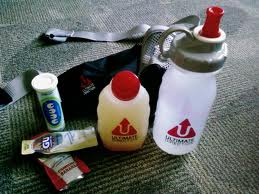Athletes exercising in summer months can suffer from dehydration especially when running or involved in endurance training. If you are a new runner, cyclist, triathlete or endurance athlete, here are my 4 steps to starting a hydration plan so you can avoid the symptoms of dehydration so you can perform in the heat of the summer.
- Determine your sweat rate.
This is very simple and you can calculate your sweat rate here. It is based on your weight lost in an hour of exercise. Multiply the pounds lost by 16 to get the ounces you need of fluids per hour (in that type of exercise – it will differ in running vs cycling).
If it is more than 20 ounces of fluids per hour, you need to add electrolytes to your fluids. If it is significantly higher, see step 3 for details on tangible testing to get exact needs. - Drink a minimum of 14 ounces per hour.
For most people, 24 ounces (a large water bottle) will be the goal. If your sweat rate is high, you may want to try for 30 ounces but more than that is usually too much. You will also need to add electrolytes to this fluid intake as drinking just water will flush electrolytes as you sweat electrolytes, too. This is known as hyponatremia, which I call accelerated dehydration.
If you know your signs of dehydration, you can start to experiment with adding an electrolyte drink, add salt and electrolyte capsule and adding sea salt to your foods or water bottle. If you need some assistance, and want exact numbers to determine your needs, look at step 4. - Learn your signs of dehydration in training!

I work with many athletes that have never paid attention to the signs of dehydration. Mostly because they did not know what to look for!
There is a certain amount of suffering expected in a race, and the long you race, the more you just expect the wheels to fall off, or nausea set in or cramping.They assume their races are just that way due to age or poor training. Once we review the signs of dehydration, and start making adjustments to their hydration plan the cramping stops, the nausea stops, they start enjoying the races and cannot believe they had suffered so long!
- Get your sweat test done!
I discovered with one one my clients a new service thru Levelen. They send you a test kit, and you can get a combo kit so you can do one test for cycling, and another for running. This testing is very easy and can provide tangible answers to the amount of fluids you need per hour, but also how much sodium and other electrolytes you need per hour. The simple test can help determine what the next steps are in your hydration plan.
For one of my clients, having the sweat test results confirmed the need to increase electrolytes as the client could see the numbers on paper, in a spreadsheet. Before this testing, they could forget to drink or add electrolytes and were inconsistent in the race efforts and suffered from muscle cramping and slowed pace during Ironman events.
If you are ready to order a sweat test kit, use NIMPA code for our 20% discount.
Whether you are a beginner athletes or a seasoned one, knowing your hydration needs can be the difference between finishing strong, or crawling over the finish line.
If you start with these 4 steps to starting a hydration plan, it will get your training and racing to where you really want it to be.
If you need some additional or personalized help with your 4 steps to starting a hydration plan, please schedule a 15 minute chat to discuss your situation.
Or schedule a Table to Race session so we can sort through the symptoms to find the optimal hydration protocol for you to race better. You don’t need just a hydration plan, but a preventive plan so you don’t get dehydrated in your half, full or ultra marathon or Ironman triathlon!